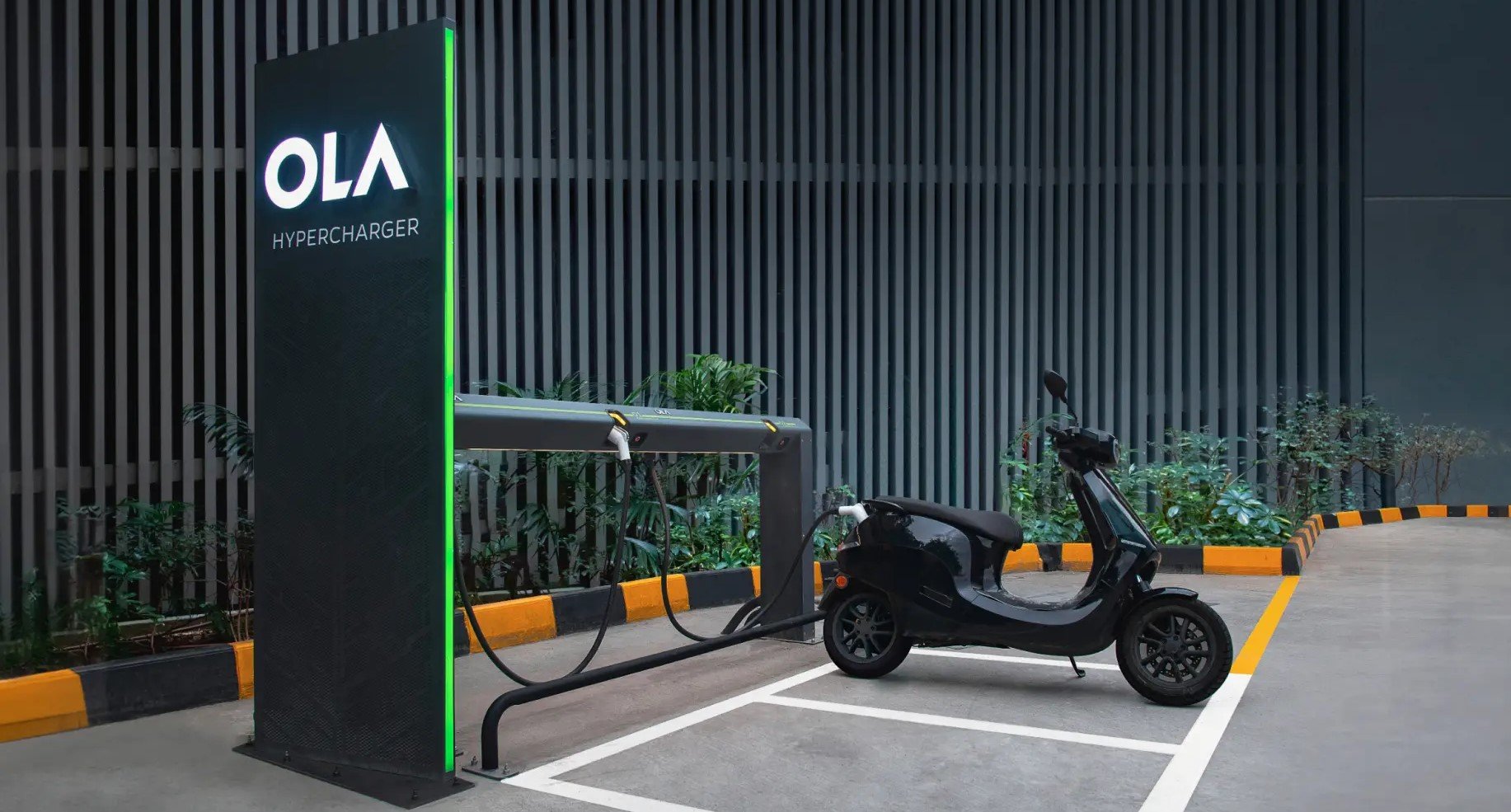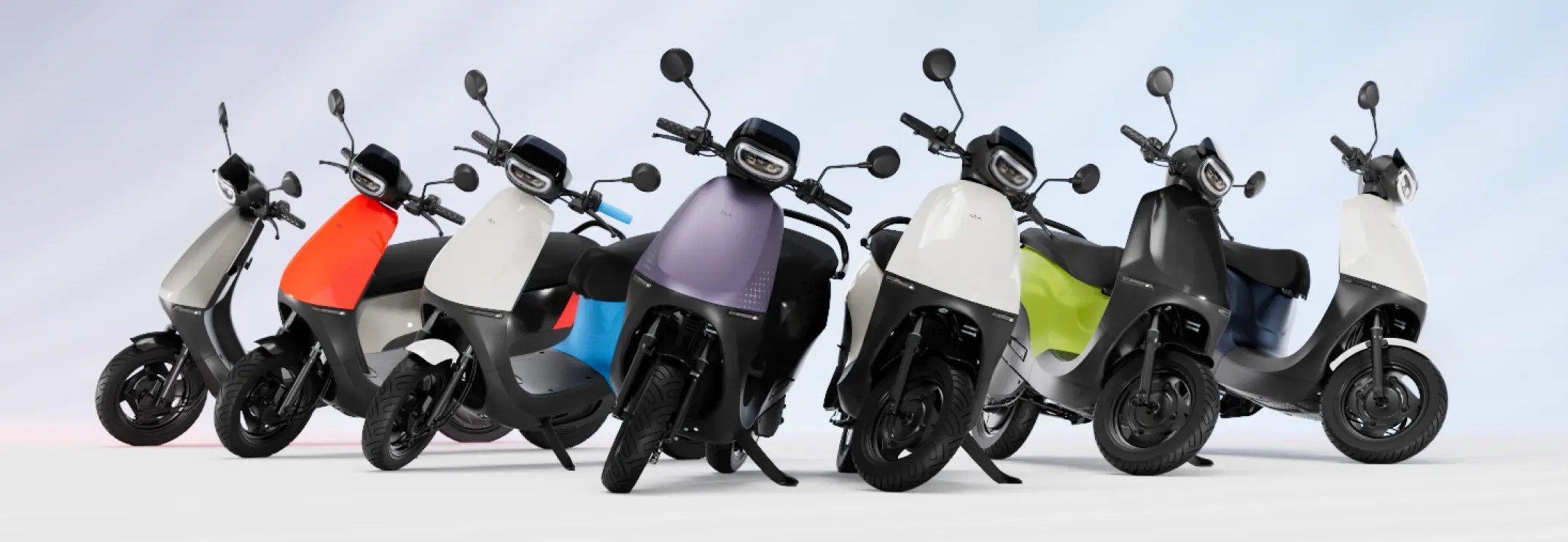Ola Electric Mobility Limited
Summary
- Largest integrated and automated Electric 2-Wheelerheeler manufacturing plant in India.
- As per early estimate the IPO expected to be open in early 2024.
- Ola is expanding Gigafactory production capacity form 1.4 GWh to 5 GWh to be ready by October 2024.

Ola Electric Mobility Limited is a major player in the Indian electric vehicle (EV) market, focusing primarily on manufacturing and selling electric scooters. The company has vertically integrated technology and manufacturing ecosystem Developing EV components like battery packs, motors and vehicle frames in-house, including cells. Recently the company announced an IPO and filed Draft Red Herring Paper (DRHP) with the Securities Exchange Board of India (SEBI), on December 22, 2023.
The Public Offer
The IPO comprises a fresh issue of Rs 5,500 crore and an offer for sale (OFS) of Rs 1,750 crore totalling Rs 7,250 crore. Existing shareholders will sell 95.19 million shares in the OFS.
Ola Electric's upcoming IPO will see a major reshuffle in ownership, with founder Bhavish Aggarwal offloading 47.3 million shares alongside early investors like AlphaWave, Alpine, DIG Investment, and Matrix, who collectively plan to divest 47.89 million shares through the Offer for Sale (OFS). This combined sale of 95.19 million shares signals a significant shift in the company's ownership structure.
The company is considering placing an additional Rs 1,100 crore worth of shares through a pre-IPO placement. If this option plays out, the fresh issue of Rs 5,500 crore would shrink accordingly.
The company plans to invest heavily in building its future, with Rs 1,226 crore for expanding its production capacity and Rs 800 crore for eliminating debt. But their biggest bet is on innovation, with Rs 1,600 crore dedicated to R&D, while Rs 350 crore will be used for strategic acquisitions and partnerships.
Recent developments
Ola Electric recently raised Rs 3,200 crore from Temasek-led investors and State Bank of India. The funds raised would be utilised towards expansion of Ola's EV business and setting up India's first lithium-ion cell manufacturing facility at Krishnagiri, Tamil Nadu, the company said in a statement.

Industry Overview
India has a large automotive market, comprising annual production of ~26Mn vehicles as of FY 2023 (excluding electric rickshaws - Source: Society of Indian Automobile Manufacturers (SIAM)). It is central to India’s manufacturing sector and the overall economy, contributing ~35% to the manufacturing GDP and 5-6% to the overall GDP in FY 2023. Further, the Indian government envisions improving contribution of the automotive industry to reach ~40% of the manufacturing GDP by FY 2026 (Source: Automotive Mission Plan 2016-26)1
While India’s (and global) vehicle production experienced a short-term decline in the FY 2020 – FY 2022 period, (due to the global shortage of semiconductors, pandemic-induced lockdowns, increase in fuel prices and volatile geo-politics driven by the Russia-Ukraine conflict), it has recovered well to ~83% of FY 2019 levels (as of FY 2023). Despite having large two-wheeler (2W) and four-wheeler passenger vehicles (4W-Passenger Vehicle) markets, India sees limited penetration, indicating a solid backdrop for medium to long-term volume growth.
Production-linked Incentive (PLI) Schemes – In 2020, the government launched PLI scheme to boost domestic manufacturing, cut down import bills, encourage exports and generate employment. These incentives are linked to incremental sales of new-age technology products manufactured domestically. The scheme invites foreign and local investors to set up new capacities and expand existing manufacturing units. With a budget of ₹ 2.73 Tn (US$ 34.1 Bn), these schemes were launched across 14 sectors, to create national manufacturing champions and an additional production of ₹ 30 Tn (US$ 375 Bn) over the next 5 years
Faster Adoption and Manufacturing (of Hybrid &) Electric Vehicles in India (FAME) - The scheme was launched in 2015 to enable a leapfrog to environmentally cleaner, sustainable, advanced, and more efficient electric vehicles-based system. Phase I (budget: ₹ 9.0 Bn (US$ 0.1 Bn)) of the scheme was launched between FY 2015 and FY 2019, while Phase II (budget: ₹ 100 Bn (US$ 1.3 Bn)) was launched in FY 2020 for 3 years and later extended up to FY 2024. Demand generation and charging infrastructure development have been the key objectives of the scheme.
Two-wheelers (2W)
India is a global production hub for two-wheelers – a total of ~19.5 Mn 2W were produced in India in FY 2023 contributing 15-20% of the world’s total 2W production, making it the second largest 2W producer in the world after China. Of the total production, ~4 Mn units were exported. 16-17 Mn units were sold domestically. Globally, India is the second largest 2W market in terms of domestic sales volumes. Value of 2W domestic market size in India was ₹1.4-1.6 Tn (US$17-20 Bn) in FY 2023.
The domestic 2W sales are still recovering from the pandemic induced decline and have reached 16- 17 Mn as of FY 2023 as opposed to the pre-pandemic levels of ~21 Mn. The high growth potential of the segment along with the partially recovered small base is projected to drive strong growth in volumes at ~11% CAGR over the next 5 years. This will enable the domestic 2W market to reach ₹2.8-3.6 Tn (US$ 35-45 Bn) size by FY 2028. Growing middle class population, increasing urbanization-led demand and favorable policy frameworks are the major growth factors.
Four-Wheeler Passenger vehicles
As per SIAM, India produced ~4.6 Mn 4W-Passenger Vehicles in FY 2023, of which ~0.7 Mn was exported and 3.9 Mn were sold domestically (domestic opportunity size of ₹3.2-3.5 Tn (US$ 40-45 Bn) at consumer prices). In terms of domestic sales, India became the world’s third largest 4W-Passenger Vehicle market (source: Economic Survey) in December 2022.
The 4W-Passenger Vehicle segment is projected to reach 5-6 Mn units in FY 2028, at a CAGR of ~6%. In terms of value, the market is projected to grow at a CAGR of 8-11% to reach ₹5.2-5.6 Tn (US$65-70 Bn) size by FY 2028.
EVs in India
2Ws are at the forefront of automotive electrification in India as Indian consumer is sensitive to initial vehicle price. E2W adoption has grown rapidly to form ~5.1% of 2W registrations in H1 FY 2024, primarily led by scooters. Moreover, EVs are likely to account for almost half of the domestic 2W sales volumes by FY 2028. E2W OEMs are also well placed to serve the exports opportunity of 100-110 Mn 2W units. Select E2W OEMs with greater control over manufacturing technology can also leverage the EV know-how to capture domestic E4W opportunity, taking their overall TAM to ₹ 8.0-9.1 Tn (US$100 to 115 Bn) in FY 2028.
E2Ws have seen an accelerated adoption journey in India, with the penetration increasing over 6x between FY 2021 and FY 2022 and over 2x between FY 2022 and FY 2023, to reach penetration levels of ~4.5% of the 2W registrations reported on the Vahan Dashboard (MoRTH) in FY 2023. It has increased further to ~5.1% in H1 FY 2024. E2W registrations (and subsequently penetration as % of overall 2W registrations) were marginally lower in Q2 FY2024 than the previous quarter due to reduction in FAME subsidy, effective from June 2023.
E2Ws are not only limited to the top cities but have also reached non-metro cities such as Kolhapur and Surat (with ~23% and ~15% E2W penetration respectively). Short & localized personal mobility needs in the smaller markets, wider distribution networks by E2W OEMs, government initiatives to promote universal household electrification & power infrastructure improvement, and focused financing support for low-mid income consumers, have driven universal adoption of E2Ws in the country.

Company Overview
Ola Electric is a pure EV player in India building vertically integrated technology and manufacturing capabilities for EVs and EV components. The company manufacture EVs and certain core EV components at the Ola Futurefactory. Ola Electric has delivered four products and additionally announced six new products. Ola Electric is building its EV hub in Tamil Nadu, India, comprising its Ola Futurefactory for EV manufacturing, upcoming Ola Gigafactory for cell manufacturing, and co-located suppliers. The company operate a direct-to-customer omnichannel distribution network across India, comprising 935 experience centres and 414 service centres, as of October 31, 2023.2
Production Facilities
Ola Electric has largest integrated and automated E2W manufacturing plant in India, spread across 400+ acres in Krishanagiri, Tamil Nadu. The company operate R&D facilities across India, UK and US including the Battery Innovation Centre where Ola Electric is developing industry leading cell and battery technology.
The company has vertically integrated technology and manufacturing ecosystem Developing EV components like battery packs, motors and vehicle frames in-house, including cells.
Ola Electric is constructing the Ola Gigafactory for cell manufacturing in Krishnagiri district in Tamil Nadu, India. Phase 1(a) of the Ola Gigafactory is expected to be operational by March 31, 2024, at which time it will have a production capacity of 1.4 GWh. The company expects to complete Phase 1(b) and expand the production capacity of the Ola Gigafactory to 5 GWh by October 2024.
Ola Electric is also building its EV hub in Krishnagiri and Dharmapuri districts in Tamil Nadu, India, which is expected to span up to 2,000 acres of land, and includes its Ola Futurefactory, its upcoming Ola Gigafactory for cell manufacturing in Krishnagiri district and co-located suppliers in Krishnagiri district. The company's EV hub includes 700 acres of land that the State Government of Tamil Nadu has reserved for two years for allotment to its suppliers that co-locate within its EV hub pursuant to a Memorandum of Understanding (“MoU”) dated February 18, 2023. Three of its direct and indirect suppliers are currently colocated in its EV hub.
Products
- Ola S1 Pro
- Ola S1 Air
- Ola S1 X+
- Motorcycles (upcoming)
Company History
| Year | Milestone |
| Mar-2021 | Ola Futurefactory ground |
| Oct-2021 | Futurefactory Plant commissioned |
| Dec-2021 | S1 Pro delivery started |
| Sep-2022 | 1st Experience centre opened |
| Sep-2022 | R&D centre established Battery Innovation Centre |
| Sep-2022 | S1 Delivery started |
| Oct-2022 | Announced S1 Air 3 models within two years of 1st product launch |
| May-2023 | 500th Experience Center Opened Built in 8 Months |
| Jun-2023 | Gigafactory Construction started Battery Innovation Centre |
| Aug-2023 | Announced S1 Pro (Gen 2) & 3 Variants of S1 X/X- |
| Dec-2023 | IPO Announced |
References




